How to Use Online Courses for Amazing B2B Lead Generation Results

I hope you enjoy this blog post. If you want Hello Bar to grow your leads, click here.
Author:
Ryan Bettencourt
Published
July 8, 2024

Looking to generate leads through online courses?
About 61% of marketers consider lead generation to be their most difficult challenge. Luckily, you can attract potential customers through targeted content and tailored experiences by using online courses.
Online courses are among the most effective and underrated inbound marketing techniques many companies are exploring today to generate B2B leads.
These courses provide a curated learning experience platform around specific problems. Therefore, the probability of qualified leads opting in to hear from you increases. They also help you convert more leads into paying customers.
This article will discuss the importance of online courses and how you can use them to generate B2B leads.
We’ll also review the steps to create a valuable course to help you generate high-quality enterprise leads.
Why Use Online Courses to Generate Leads?
Creating valuable online courses has gained popularity over the years, particularly among B2B organizations. Here’s why you should consider using online courses to generate and nurture leads for your B2B business:
A Wider Reach
Online courses can reach a wider audience compared to traditional in-person workshops or events. Further, they can be accessed by anyone and you can use different platforms to ensure they’re shared widely.
For instance, courses have become very popular on LinkedIn, allowing you to learn and represent new skills. This is why most LinkedIn marketing services recommend them.
Professionals can enhance their skill set or acquire a new skill to switch occupations. These courses can be included when updating their resume.
An Opportunity To Build Relationships with Prospects
Through online courses, you can provide valuable content for your target audience and establish yourself as an authority in your field. By doing so, you’ll generate more quality leads and slowly nudge them down your marketing funnel.
For instance, ecommerce platforms can provide marketing courses to help customers boost revenue for their online businesses. This way, prospects will not only trust your brand but also consider your ecommerce platform as the software they need to scale.
Simplify Complicated Products
Brands can simplify their complicated products and services into easy-to-understand online courses.
Take Shopify for instance. The ecommerce platform has offered over 230 online courses to over 750k students. These courses are meant to simplify their platform for their customers and boost customer engagement.
As a result, this helped them achieve faster growth and better product adoption. Shopify’s learner engagement and academy usage has grown by 491% according to a recent case study.
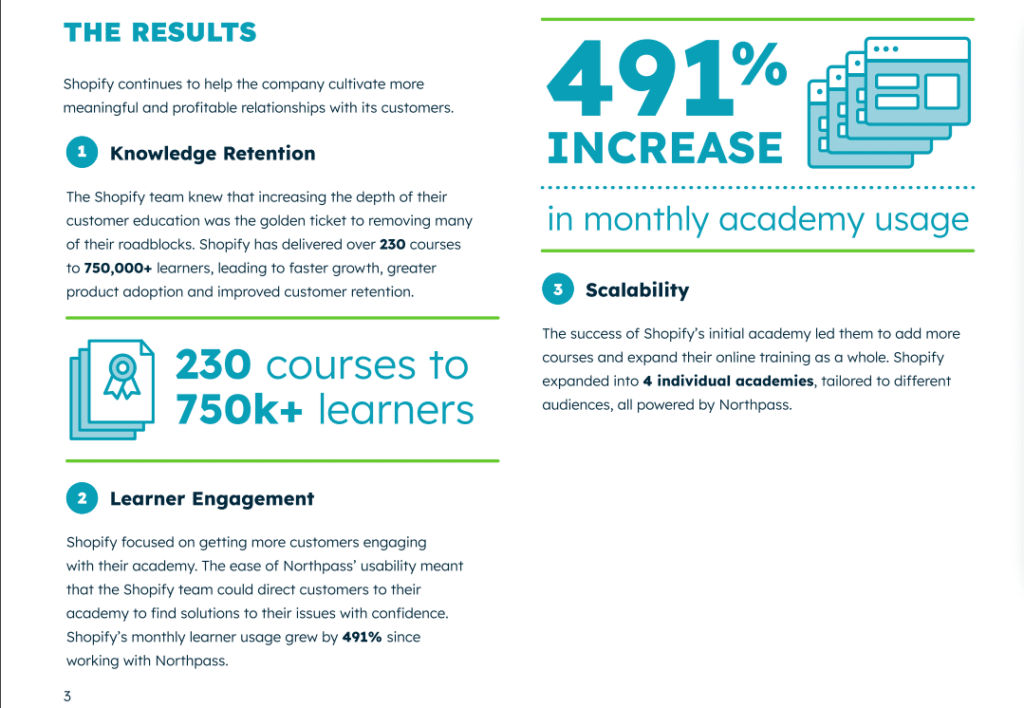
Image via Northpass
5 Steps to Use Online Courses to Generate B2B Leads
Businesses from all sectors are developing comprehensive online courses to sell them as digital products. These online courses are also part of a larger lead generation plan based on significant demand from prospective consumers.
Let’s take a deep dive into the process of creating courses that sell and how you can utilize them to generate great B2B leads.
1. Choose the Right Topic
Choosing the right topic is the first and most important step of online course creation.
You have to choose the topic based on your expertise and customer persona.
So the first step towards choosing your topic would be to define your ideal customer by building a persona. A customer persona is a representation of a large segment of your target audience that you build through extensive customer research.
It tells you what pushes your ideal customer to buy our products. This helps you understand your ideal customer, their issues, and the solutions they’re seeking.
You can then use that knowledge coupled with your expertise, to choose the right topic for your course.
Here are some popular examples of course topics by top enterprises:
- B2B marketing
- B2B sales
- B2B lead generation
- B2B content creation and social media
- Digital transformation
- Specific tool-based courses, like Excel
- ecommerce for business
- B2B business development
Overall choosing an ideal topic is an important step in generating leads through online courses. Next, you’ll need to make sure that your course content solves your audience’s problem.
The ideal customer will test the limits of what your product can do. They’ll drive innovation and reusability. Eventually, if they value your product enough, they’ll recommend it to others and become your brand advocate.
However, for this to happen, you need to solve a major problem they’re facing through your course. Here’s a case in point.
Later, a SaaS company, found that people struggled to use their software effectively. So they developed a course that educated customers on how to increase their social media following using the software.
The course was a huge success, resulting in a 320% boost in client retention!
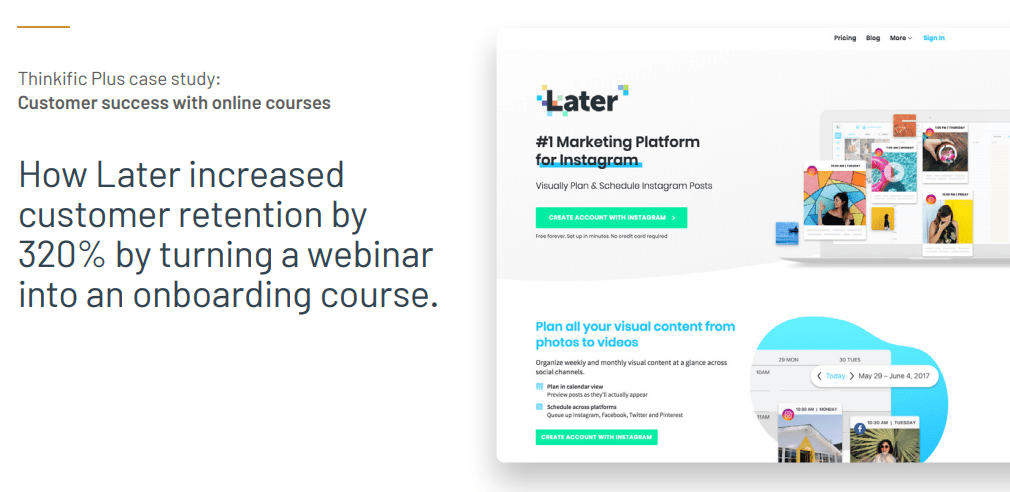
Image via Thinkific
2. Design an Info-Packed Course That Will Sell
Once you have the topic and solution ready, it’s time to design the course. Hundreds of other online courses are already providing the same things as yours.
So how can you convince consumers to choose yours over the others?
The solution is simple: people pay you with time or money. Make sure you’re providing equal or more value than what they’re paying.
Here are some quick steps you can follow to create a value-packed course:
Create a Course Outline
A course outline functions as a road plan for your online course, guiding students from point A to point B.
It will:
- Assist you in delivering knowledge to your leads in a systematic, orderly manner, building skill upon skill until they complete your course.
- Give you an idea about where your course is headed.
- Guide you on how you should design your course to offer an excellent learning experience.
Here’s what a course outline looks like:
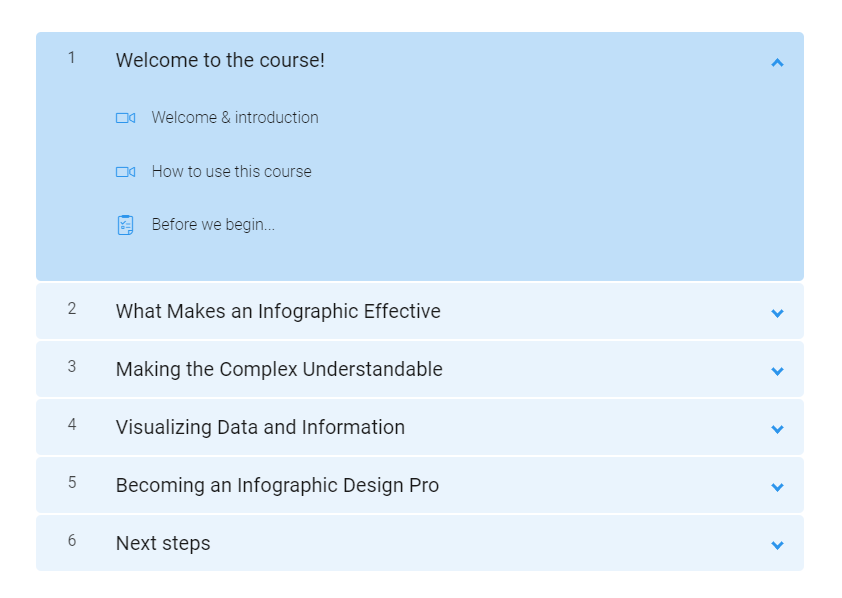
Image via Venngage
Design Professional Business Presentation Slides
To generate leads, you’ll need to use varying teaching methods to present your online courses. One way is through compelling, professional business presentation slides.
These help you:
- Communicate important ideas
- Persuade people
- Introduce new products to the world
Make sure you create visually appealing yet interactive and professional slides that demonstrate your expertise and simplify business concepts.
You can also create infographics in your presentations to get your audience’s attention. Infographics also help you establish your brand voice, and make your content easy to understand.
Utilizing infographics to improve brand presence can also help enhance the overall visual appeal of your presentations.
Create Professional Videos and Resources
People tend to remember 65% of the visual content even after three days of viewing it, compared to only 10% of text content.
As a result, making professional videos is one of the most effective ways to educate your target audience and make learning simpler and more interactive. The best LMS Plugins support video-based learning, allowing course creators to embed videos, create interactive lessons, and track learner engagement to enhance the overall educational experience.
Additionally, high-quality captions are also necessary to ensure that your content is accessible for everyone. So don’t compromise on this. Also make sure that each video has accurate and easy-to-follow subtitles.
HubSpot is an excellent case in point here.
Their online courses include high-quality short videos with subtitles, cheat sheets, and quizzes at the end of each lesson to provide greater value to their audience.
Beautiful-made explainer videos allow students to learn at their own pace. This gives them optimal flexibility to incorporate their education into their schedules.
Choose the Right Platform
The online learning platform for your course is as important as the course itself. It’s responsible for end-to-end course delivery, audience interaction, and the overall learning experience.
So, choose a platform that provides you with the power and flexibility you need to fulfill your business objectives.
You can sell your course directly through your website, or you can collaborate with course-selling websites. The latter will provide you with the tools you need to promote it.
Coursera is such a site that allows you to reach a larger audience.
Salesforce, a B2B CRM and cloud solutions company, uses Coursera as its course hosting platform.
Even though Salesforce is a well-known company with a fully functioning website, they chose Coursera because it enables the brand to reach a far wider audience and handles course delivery like a breeze.
Irrespective of the platform you choose, it should allow you to:
- Create your branded course content (with custom fonts, colors, and templates)
- Upload content in different formats, like text, videos, and infographics.
- Analyze your course’s statistics with sign-ups, revenue graphs, and unsubscribe count.
- Create a sales page for your course that explains who it’s for, what they’ll learn, and why it’s a good fit for them.
- Accept payments globally through a seamless system.
3. Promote the Course to Your Audience
There are a million innovative approaches to building an audience and promoting your online courses. However, it’s easy to get overwhelmed when you have too many strategies to employ.
Start with these effective strategies for targeting a B2B audience with your course:
LinkedIn Outreach
LinkedIn users are four times more likely than Facebook users to visit your B2B website.
And LinkedIn’s online visitor-to-lead conversion rate is a stunning 2.74%. This is more than three times that of Facebook and Twitter combined.
This enterprise-focused platform can help you build the ideal audience for your online course. It will allow you to create content about your area of expertise, promote your course through it, and generate leads.
Here’s how Tony Robbins, a life and business strategist, uses his LinkedIn account to promote his course on how to increase accountability.

Image via Tony Robbins
To create a successful LinkedIn outreach campaign, you can also leverage LinkedIn automation tools. For instance, LinkedIn allows you to cold message people in your niche and develop a connection with them.
Leverage LinkedIn Sales Navigator
The LinkedIn Sales Navigator is a social selling platform with tools to help salespeople find prospects and drive traffic.
It allows users to interact with LinkedIn’s 700 million professionals using various tools created by the company.
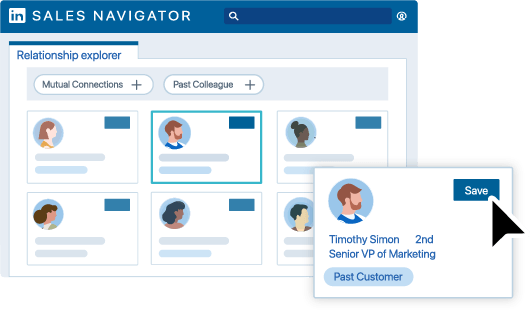
Image via LinkedIn
Here’s a common use case on how to use Sales Navigator to generate leads and build relationships:
- Make a search using specified keywords and filters
- Export leads and create a CSV file
- Find emails of the leads using tools like Hunter.
- Start a cold email campaign with an email outreach strategy:
Email Outreach
Now that you have an email list of your leads, it’s crucial to reach out using the right prospecting tools. Establish a relationship with them, and win their confidence by providing relevant tips and advice.
When you offer them value and build a connection, they are more likely to buy your course when you eventually promote it to them.
Teachable, a platform that allows users to develop online courses, uses emails like these to establish a relationship with their prospects by providing them with helpful resources.
According to a HubSpot survey, 53% of marketing professionals believe email marketing is the most effective channel for generating early-stage leads.
For marketing your online course, closing sales, and growing your business, email marketing is one of the most valuable and powerful assets you can have because:
- You can send emails to your audience’s device regularly.
- In comparison to other platforms, email is still extremely popular.
- You’re less likely to lose your audience due to a platform’s shutdown, suspension, or just diminishing popularity.
- Everyone on your email list has previously shown interest in your content or product.
- Email messaging is much simpler to automate.
- You can integrate email with social media and reach a much wider audience.
Paid Advertising
Promoting your online courses organically can yield stellar results. However, it tends to take more time and is more suitable as a long-term strategy. You can move things along faster through paid advertising.
This includes using:
- Facebook ads and Instagram ads
- YouTube ads
- Google ads
- Pay-per-click
Through paid advertising, you can create highly targeted promotions to generate targeted leads for your online courses.
To improve the effectiveness of your ads, be sure to keep them brief and make them mobile-friendly. Include clear CTAs so you can lead your viewers directly to your website.
4. Offer a Condensed Version of Your Course as a Lead Magnet
This refers to offering a bare-bones version of your course to generate leads and get more conversions. This could be in form of a brief eBook or guide. You can offer these lead magnets to your audience for free.
These free resources act as an attraction for your paid courses. You can use them to capture the email addresses of potential students.
This way, you can then target them with emails that display your authority around the topic, and promote your main online course.
Here are some examples of lead magnets you may use to market online courses:
Ebooks
As one of the most popular lead magnets, Ebooks offers high conversion rates. They’re also simple to create. All you’ll need to do is repurpose and build on your existing course content.
You can offer a super condensed version of your course as a small 20-page eBook. Be sure to include a strong call-to-action at the end to drive conversions for your paid course.
Webinars
Before launching your courses, you can host webinars to provide a glimpse of what the course has to offer.
Webinars are game-changing marketing channels that enable you to substantially improve sales for your business, regardless of what sector or niche you serve.
In fact, more than half of marketers (53%) believe webinars are the most effective top-of-funnel form for generating high-quality leads.
With free webinars as his primary customer acquisition channel, John Michaloudis, a coach, and founder of myexcelonline.com, grew his revenue from $0 to over $20,000 per month in only six months.
Mini-Courses
Make a free mini-course out of particular parts or concepts from your main course and distribute it.
If your audience wants to learn more about the topic, you can invite them to purchase your paid course at the end of the free course with a compelling call to action.
You can also use popups to promote these mini-courses on your website or blog.
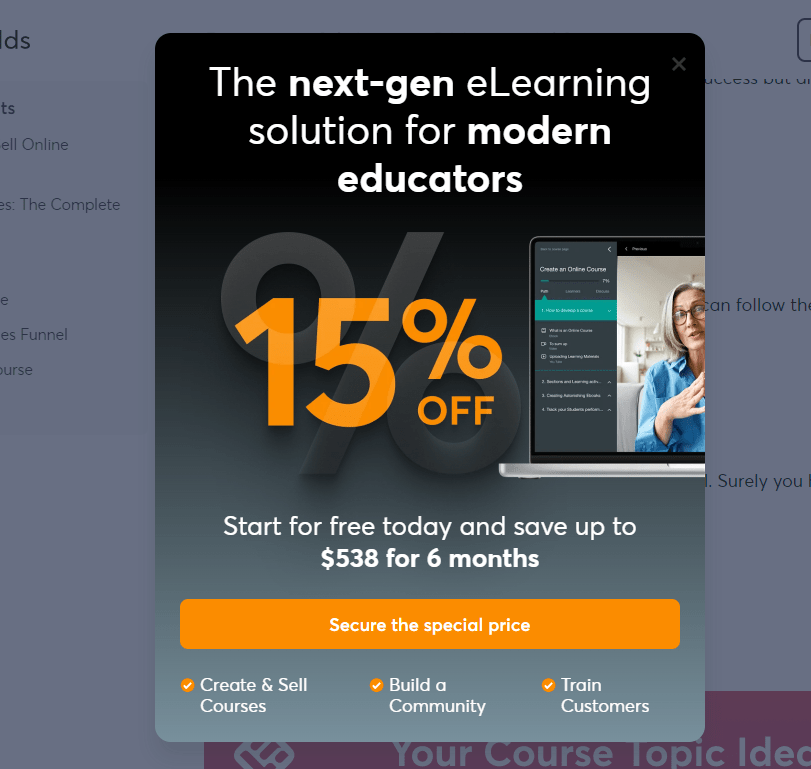
Image via LearnWorlds
Thinkific is a platform that enables you to create, market, and sell online courses.
Checklists
Checklists are another lead magnet you can offer your prospects for free to help promote your main course. This resource provides a specific path for customers to follow to achieve certain goals.
You can link the content on your checklist to your online course by providing it as a tool.
For instance, it could list the skills you should master by the end of a course to help complete your teachings. In such instances, a checklist acts as a guide to help potential leads make the most out of a course you provide.
Alternatively, it could be a condensed version of a course to act as a simple guide.
Other types of lead magnets you can use include guides, templates, reports, cheat sheets, PowerPoint templates, and so on.
5. Nurture the Leads After They Complete the Course
By this stage of your lead generation funnel, you should have a decent amount of leads coming in from your online course.
However, nurturing these leads is more important since acquiring a new customer is five times more expensive than retaining an existing one.
Good customer relationship management tools (CRM) come in handy in this situation. A good CRM serves as a database for your contact list and helps convert leads into customers.
By employing a CRM to automate the lead generation process, you can ensure that each lead receives tailored content at the proper time. Here are more steps you can take:
- Add a link to your calendar and make scheduling a meeting with your sales rep simple.
- Eliminate manual work and automate the sales process. Do so by sending automated engagement sequences and automated follow up emails.
As a result, your leads will go smoothly through each level of your sales funnel. This will in turn enable you to convert them into long-term happy customers.
FAQs
Q1. What types of online courses are most effective for lead generation?
Here are some of the popular types of courses you can create to generate leads:
- Mini-courses
- Tutorial series
- Community-based learning courses
- Membership-based Periodical courses
- Interactive courses
- Workshop and webinar courses
Q2. Can online courses help with upselling and cross-selling other products or services?
As a lead generation strategy, you can use online courses to upsell and cross-sell other products and services.
For instance, courses that help simplify how to use software help customers realize the full potential of the software. As such, you can use these courses to upsell premium packages.
Q3. How to track and measure the success of my online courses in generating leads?
Here are some metrics you can track to measure the success of your online courses in generating leads:
- Lead quality
- Website traffic
- Learner engagement rates
- Your customer retention rates
- Conversion rates
Q4. What incentives can I offer to encourage B2B professionals to enroll in online courses?
Some incentives include:
- Offering occasional course discounts
- Bundling related courses at discounted prices
- Using free lead magnets like ebooks, webinars, checklists, etc
- Rewarding referrals
Q5. How can I ensure my online course content remains relevant and up-to-date?
The best way to keep your online course relevant is by refreshing its content year after year. Make sure it reflects what’s current in the business world.
Here are some key pointers on how to do so:
- Explore podcasts from industry gurus
- Check the latest reports, statistics, and case studies
- Check blogs from industry leaders
- Attend industry events and conferences
Conclusion
From virtual coaches to businesses that sell digital products, everyone is trying to harness the power of online courses. To generate B2B leads, nurture and convert them, and eventually enhance client retention.
As a result, the number of courses available is also rapidly expanding, providing people with many options.
So it’s critical to research what your competitors have to offer and develop a course that adds even more value to your audience.
By following the steps outlined in this article, you can generate leads through online courses and propel your company to new heights.







